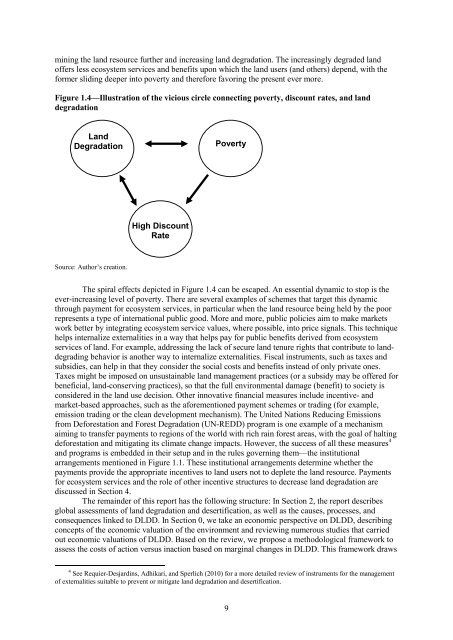The Economics of Desertification, Land Degradation, and Drought
The Economics of Desertification, Land Degradation, and Drought
The Economics of Desertification, Land Degradation, and Drought
Create successful ePaper yourself
Turn your PDF publications into a flip-book with our unique Google optimized e-Paper software.
mining the l<strong>and</strong> resource further <strong>and</strong> increasing l<strong>and</strong> degradation. <strong>The</strong> increasingly degraded l<strong>and</strong><br />
<strong>of</strong>fers less ecosystem services <strong>and</strong> benefits upon which the l<strong>and</strong> users (<strong>and</strong> others) depend, with the<br />
former sliding deeper into poverty <strong>and</strong> therefore favoring the present ever more.<br />
Figure 1.4—Illustration <strong>of</strong> the vicious circle connecting poverty, discount rates, <strong>and</strong> l<strong>and</strong><br />
degradation<br />
<strong>L<strong>and</strong></strong><br />
<strong>Degradation</strong><br />
Source: Author’s creation.<br />
High Discount<br />
Rate<br />
Poverty<br />
<strong>The</strong> spiral effects depicted in Figure 1.4 can be escaped. An essential dynamic to stop is the<br />
ever-increasing level <strong>of</strong> poverty. <strong>The</strong>re are several examples <strong>of</strong> schemes that target this dynamic<br />
through payment for ecosystem services, in particular when the l<strong>and</strong> resource being held by the poor<br />
represents a type <strong>of</strong> international public good. More <strong>and</strong> more, public policies aim to make markets<br />
work better by integrating ecosystem service values, where possible, into price signals. This technique<br />
helps internalize externalities in a way that helps pay for public benefits derived from ecosystem<br />
services <strong>of</strong> l<strong>and</strong>. For example, addressing the lack <strong>of</strong> secure l<strong>and</strong> tenure rights that contribute to l<strong>and</strong>degrading<br />
behavior is another way to internalize externalities. Fiscal instruments, such as taxes <strong>and</strong><br />
subsidies, can help in that they consider the social costs <strong>and</strong> benefits instead <strong>of</strong> only private ones.<br />
Taxes might be imposed on unsustainable l<strong>and</strong> management practices (or a subsidy may be <strong>of</strong>fered for<br />
beneficial, l<strong>and</strong>-conserving practices), so that the full environmental damage (benefit) to society is<br />
considered in the l<strong>and</strong> use decision. Other innovative financial measures include incentive- <strong>and</strong><br />
market-based approaches, such as the aforementioned payment schemes or trading (for example,<br />
emission trading or the clean development mechanism). <strong>The</strong> United Nations Reducing Emissions<br />
from Deforestation <strong>and</strong> Forest <strong>Degradation</strong> (UN-REDD) program is one example <strong>of</strong> a mechanism<br />
aiming to transfer payments to regions <strong>of</strong> the world with rich rain forest areas, with the goal <strong>of</strong> halting<br />
deforestation <strong>and</strong> mitigating its climate change impacts. However, the success <strong>of</strong> all these measures 4<br />
<strong>and</strong> programs is embedded in their setup <strong>and</strong> in the rules governing them—the institutional<br />
arrangements mentioned in Figure 1.1. <strong>The</strong>se institutional arrangements determine whether the<br />
payments provide the appropriate incentives to l<strong>and</strong> users not to deplete the l<strong>and</strong> resource. Payments<br />
for ecosystem services <strong>and</strong> the role <strong>of</strong> other incentive structures to decrease l<strong>and</strong> degradation are<br />
discussed in Section 4.<br />
<strong>The</strong> remainder <strong>of</strong> this report has the following structure: In Section 2, the report describes<br />
global assessments <strong>of</strong> l<strong>and</strong> degradation <strong>and</strong> desertification, as well as the causes, processes, <strong>and</strong><br />
consequences linked to DLDD. In Section 0, we take an economic perspective on DLDD, describing<br />
concepts <strong>of</strong> the economic valuation <strong>of</strong> the environment <strong>and</strong> reviewing numerous studies that carried<br />
out economic valuations <strong>of</strong> DLDD. Based on the review, we propose a methodological framework to<br />
assess the costs <strong>of</strong> action versus inaction based on marginal changes in DLDD. This framework draws<br />
4 See Requier-Desjardins, Adhikari, <strong>and</strong> Sperlich (2010) for a more detailed review <strong>of</strong> instruments for the management<br />
<strong>of</strong> externalities suitable to prevent or mitigate l<strong>and</strong> degradation <strong>and</strong> desertification.<br />
9

















